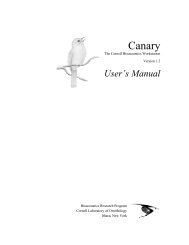Tally Sheet - Cornell Lab of Ornithology
Tally Sheet - Cornell Lab of Ornithology
Tally Sheet - Cornell Lab of Ornithology
You also want an ePaper? Increase the reach of your titles
YUMPU automatically turns print PDFs into web optimized ePapers that Google loves.
Project FeederWatch<br />
<strong>Tally</strong> <strong>Sheet</strong><br />
Effort<br />
When did you watch your FeederWatch<br />
Count Site?<br />
q Day 1, morning q Day 1, afternoon<br />
q Day 2, morning q Day 2, afternoon<br />
Estimate the cumulative time you<br />
watched your FeederWatch Count Site.<br />
q Less than 1 hour q 4+ to 8 hours<br />
q 1 to 4 hours q More than 8 hours<br />
Weather<br />
Daylight temperature<br />
Mark the temperature extremes for each<br />
count day. Submit only the extreme low<br />
and high for the two-day count.<br />
Low High<br />
Day Day Day Day<br />
1 2 Temperature 1 2<br />
q q Under -18°C (under 0°F) q q<br />
q q -18° to -10°C (0° to 14°F) q q<br />
q q -9° to 0°C (15° to 32°F) q q<br />
q q 1° to 10°C (33° to 50°F) q q<br />
q q 11° to 20°C (51° to 68°F) q q<br />
q q Over 20°C (over 68°F) q q<br />
Daylight precipitation<br />
Indicate the kind <strong>of</strong> precipitation that occurred<br />
during the two-day count.<br />
Type Duration<br />
q None q Under 1 hour<br />
q Rain q 1 to 3 hours<br />
q Rain and Snow q 3 to 6 hours<br />
q Snow q Over 6 hours<br />
Total depth <strong>of</strong> ice/snow cover<br />
Mark the average conditions during the<br />
two-day count.<br />
q None<br />
q Under 5 cm (under 2")<br />
q 5 cm to 15 cm (2" to 6")<br />
q Over 15 cm (over 6")<br />
q Hard crust or ice covers snow<br />
q Snow cover is patchy (less than 50% cover)<br />
FeederWatch ID number: Online password: Online login name:<br />
The dates <strong>of</strong> this count are ___________ and ___________<br />
Use the space below to tally the number <strong>of</strong> each bird species you see at<br />
one time. Report your highest counts to Project FeederWatch using online<br />
or paper data forms (do not send in the tally sheet). Report only the highest<br />
number seen at one time—do not add your counts together.<br />
Species name Highest number seen at one time<br />
House Finch 3 5 12 (Example—report 12 House Finches)<br />
___________________________________________________________________________________<br />
___________________________________________________________________________________<br />
___________________________________________________________________________________<br />
___________________________________________________________________________________<br />
___________________________________________________________________________________<br />
___________________________________________________________________________________<br />
___________________________________________________________________________________<br />
___________________________________________________________________________________<br />
___________________________________________________________________________________<br />
___________________________________________________________________________________<br />
___________________________________________________________________________________<br />
___________________________________________________________________________________<br />
___________________________________________________________________________________<br />
___________________________________________________________________________________<br />
___________________________________________________________________________________<br />
___________________________________________________________________________________<br />
___________________________________________________________________________________<br />
___________________________________________________________________________________<br />
___________________________________________________________________________________<br />
___________________________________________________________________________________<br />
___________________________________________________________________________________<br />
___________________________________________________________________________________<br />
___________________________________________________________________________________<br />
___________________________________________________________________________________<br />
___________________________________________________________________________________<br />
___________________________________________________________________________________<br />
___________________________________________________________________________________<br />
___________________________________________________________________________________<br />
Helpful hints<br />
• Under “Species name,” list the birds you see most <strong>of</strong>ten. Then make<br />
copies <strong>of</strong> your tally sheet.<br />
• Print tally sheets from our web site at:<br />
Quick Instructions<br />
1. Select your Count Site<br />
Choose a portion <strong>of</strong> your yard that is easy to monitor, typically an<br />
area that is visible from your home.<br />
2. Choose your Count Days Select two consecutive days within each count period (paper<br />
forms) or week (online). Counts must be at least five days apart<br />
(leave at least five days when you do not count between each <strong>of</strong><br />
your two-day counts).<br />
3. How to count<br />
4. What to count<br />
5. Report your counts<br />
6. Optional reports<br />
Record the maximum number <strong>of</strong> each species visible at any one<br />
time during your two-day count. Do not add your counts together!<br />
Please count<br />
• all <strong>of</strong> the individuals <strong>of</strong> each species in view at any one time<br />
• birds attracted to food or water you provided<br />
• birds attracted to fruits or ornamental plantings<br />
• hawks and other predatory birds that are attracted by the<br />
birds at your feeders<br />
But do not count<br />
• birds that simply fly over the count site<br />
• birds seen on non-count days<br />
Submit your data to Project FeederWatch via the Internet at<br />
www.feederwatch.org or using a paper data booklet. This tally<br />
sheet is for your own record-keeping and cannot be used for<br />
submitting data.<br />
To report rare, sick, or unusual birds or to submit comments, follow<br />
links to the appropriate forms on the data entry home page<br />
or include notes with your data booklet. At the end <strong>of</strong> each season,<br />
please describe your count site by following the "Your Count<br />
Site" link from the data entry home page or filling out the Count<br />
Site Description Form in your data booklet.<br />
For complete instructions see Instruction Booklet,<br />
or go to www.feederwatch.org and click on the "Instructions" button.<br />
For assistance, contact the Project FeederWatch <strong>of</strong>fice in your country.<br />
United States<br />
<strong>Cornell</strong> <strong>Lab</strong> <strong>of</strong> <strong>Ornithology</strong><br />
159 Sapsucker Woods Road<br />
Ithaca, New York 14850<br />
(607) 254–2427<br />
www.feederwatch.org<br />
Data entry questions: pfwonline@cornell.edu<br />
Bird-related questions: feederwatch@cornell.edu<br />
©2009 <strong>Cornell</strong> <strong>Lab</strong>oratory <strong>of</strong> <strong>Ornithology</strong><br />
Canada<br />
Bird Studies Canada<br />
P.O. Box 160<br />
Port Rowan, Ontario N0E 1M0<br />
(888) 448–BIRD (2473)<br />
www.bsc-eoc.org/volunteer/pfw<br />
email address: pfw@bsc-eoc.org<br />
Project FeederWatch is a research and education project <strong>of</strong> the <strong>Cornell</strong> <strong>Lab</strong> <strong>of</strong> <strong>Ornithology</strong> and Bird Studies Canada.

















